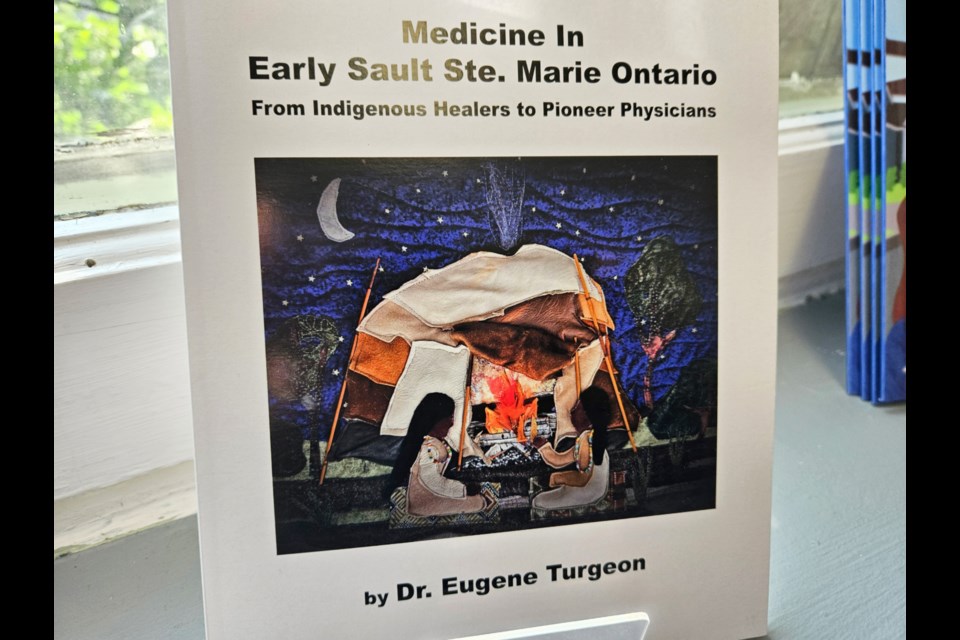Dr. Gene Turgeon, a now-retired local dermatologist, has drawn on his own ancestral roots to write a history of medicine in Sault Ste. Marie.
The book, released two weeks ago, is entitled Medicine In Early Sault Ste. Marie Ontario: From Indigenous Healers to Pioneer Physicians.
“I was in a unique position to write this book because I am of Algonquin and European ancestry so I certainly had an interest in the Indigenous healing side,” Turgeon told SooToday.
He began his medical career as a Sioux Lookout-based doctor flying into 28 remote communities before moving to the Sault to practice medicine in 1975.
“Treatment was often carried out by Indigenous healers in those communities. Generally speaking they did not want to share that information beyond their communities but I was able to gain their confidence in some cases and then we started to share information back and forth,” Turgeon said.
After moving to Sault Ste. Marie, Turgeon met Dan Pine of Garden River First Nation.
Pine, a grandson of Chief Shingwauk and a deeply respected Indigenous healer, took Turgeon into his confidence and the two men began a friendship that grew deep enough for Pine to give Turgeon’s daughter the name Wasaya, which means ‘rising sun.’
With knowledge of Indigenous medicine in mind, historical information regarding the history of European medicine in the Sault then fell into Turgeon’s hands.
“One day in my office about 30 years ago two ladies came to my office with a box filled with documents. They had walked up from the museum. They had taken four boxes of stuff they found in an old closet at the Plummer Memorial Hospital. There were some medical artifacts inside and so the museum took four of the boxes but the last box was paper documents the museum didn't want. They asked me if I wanted this information and I said ‘sure.’”
“Inside there was a book that was written in 1922 about the history of the medical profession written by doctors that were here at that time.”
That book contained information about the first European doctors in the Sault.
With the book in his possession, he also later spent a great deal of time going through information stored at the Sault Ste. Marie Public Library.
“I’ve found some amazing stories,” Turgeon said.
He discovered that many of the Sault and area’s first doctors were British-trained 18th century Hudson's Bay Company store managers assigned to not only oversee the commerce but also to provide health care to their employees.
Turgeon found that the first doctor to arrive to take care of the public’s health care needs was a Dr. Simpson, arriving from England in 1850, a second physician following in 1863.
The first doctor to come to the Sault and stay was a Dr. Reid in 1880.
Doctors who came here to hang out their shingles were University of Toronto medical school graduates who found the north appealing.
“One thing I found interesting was that a quarter of the doctors that came here had been teachers before they went into medicine,” Turgeon said.
“One of them had been a teacher and a principal here in the Sault for 13 years before he went into medicine. I think that’s great because when you’re a physician basically you’re teaching your patients all the time.”
Doctors’ availability in those days included morning, afternoon and evening hours.
Several doctors served on what was known as the town council.
In 1920, Dr. Alexander Sinclair was an internationally recognized surgeon who bought X-ray equipment for the local hospital.
Turgeon’s book includes photographs of many physicians who practiced in the Sault over the years.
Medicine In Early Sault Ste. Marie Ontario: From Indigenous Healers to Pioneer Physicians takes readers up to the 1930s, 40s and 50s.
“I’d been working on it for about a year but I’d been collecting the information for a long time.”
He said what inspired him to write the book was his attendance at the official opening of Shingwauk Kinoomaage Gamig in Sept. 2022.
“I took a guided tour of the medicine garden and it brought back memories of Dan Pine.”
After that occasion, Turgeon gathered a large amount of information regarding Indigenous medicine through a series of meetings with Indigenous leaders.
He said that he is naturally pleased with advances made in modern medicine but would have preferred to receive Indigenous healing in the 19th century.
At that time, European doctors believed that healing could be achieved through withdrawing a quantity of blood from a patient's veins along with draining the body of ‘humors,’ a term for blood and other body fluids.
“I think that during that time when the humoral theory of disease reigned in European medicine featuring bloodletting and boring holes in skulls to let the bad humor out, I would definitely have opted for an Indigenous healer.”
Turgeon worked emergency shifts for his first 20 years in the Sault, drawing on his experience in remote northern Ontario communities.
He worked as a general practitioner with additional training in dermatology, working exclusively in dermatology for his last 15 years in medicine.
He retired in 2016.
Medicine In Early Sault Ste. Marie Ontario: From Indigenous Healers to Pioneer Physicians was released two weeks ago and is on sale at Sweet Greetings locations situated within I.D.A. stores, the Sault Ste. Marie Museum, the Ermatinger Clergue National Historic Site and the Sault Area Hospital gift shop.
The book's front cover art, entitled Knowledge Shared, was created by local multi-media artist Nancy Sachro. Her inspiration came from several 19th-century paintings showing the encampment at Sault Ste. Marie.
